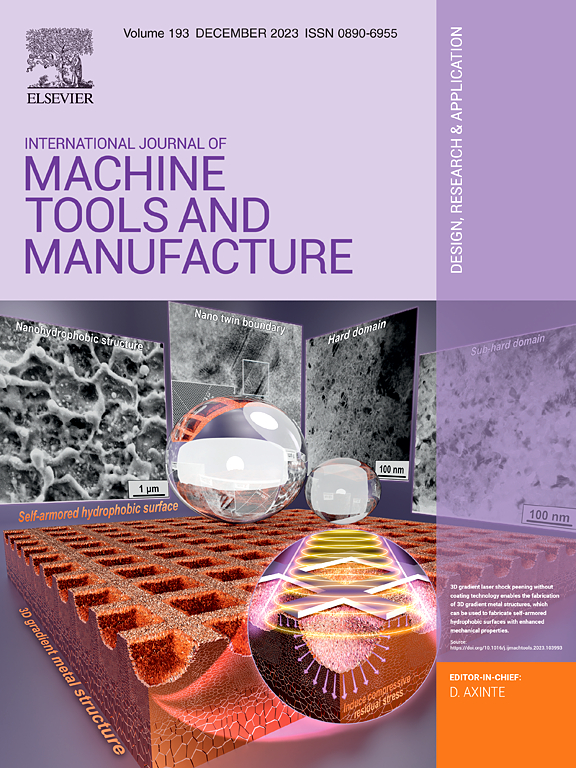Ultrafast phase transformation and strengthening mechanisms in alloys induced by femtosecond laser shock: a novel strategy for intermetallic control
IF 18.8
1区 工程技术
Q1 ENGINEERING, MANUFACTURING
International Journal of Machine Tools & Manufacture
Pub Date : 2025-05-17
DOI:10.1016/j.ijmachtools.2025.104292
引用次数: 0
Abstract
This study proposes a novel alloy-strengthening strategy enabled by femtosecond laser shock peening (FLSP), which utilizes ultrahigh peak shock pressures exceeding the intrinsic bond rupture strength of metallic bonds to achieve atomic-level microstructural modification. In contrast to conventional nanosecond laser shock peening (NLSP), FLSP induces a distinct strengthening mechanism through the dynamic fragmentation of intermetallic phases and the controllable precipitation of nanoscale strengthening phases. Through integrating a synergistic experimental investigation with molecular dynamics (MD) simulation, we establish a generalized pressure–dependent phase transformation framework, identifying critical thresholds of shock pressure required to initiate atomic bond rupture and subsequent phase evolution. This framework enables precise tuning of energy input to promote the formation of nanoscale strengthening phases while suppressing undesirable microscale precipitates. Compared to NLSP, FLSP demonstrates superior efficacy in microstructure refinement capabilities, enabling synergistic strengthening through grain refinement, dislocation multiplication, and pressure-mediated phase transformation. Notably, the discovered pressure–sensitive phase evolution behavior provides a transferable paradigm for microstructural design and performance optimization across a wide range of metallic systems. This work advances the fundamental understanding of laser–matter interactions under extreme conditions and offers a physics-informed pathway for the design of high-performance structural materials through targeted laser parameter engineering.

飞秒激光冲击诱导合金的超快相变和强化机制:一种新的金属间控制策略
本研究提出了一种新型的飞秒激光冲击强化(FLSP)合金强化策略,该策略利用超过金属键固有键断裂强度的超高峰值冲击压力来实现原子级微结构改性。与传统的纳秒激光冲击强化(NLSP)相比,FLSP通过金属间相的动态破碎和纳米级强化相的可控析出诱导出独特的强化机制。通过将协同实验研究与分子动力学(MD)模拟相结合,我们建立了一个广义的压力相关相变框架,确定了启动原子键断裂和随后的相演化所需的冲击压力的临界阈值。该框架能够精确调整能量输入,以促进纳米级强化相的形成,同时抑制不需要的微尺度沉淀。与NLSP相比,FLSP在微观组织细化能力方面表现出更高的效率,可以通过晶粒细化、位错倍增和压力介导的相变实现协同强化。值得注意的是,所发现的压敏相演化行为为广泛的金属体系的微结构设计和性能优化提供了可转移的范例。这项工作促进了对极端条件下激光与物质相互作用的基本理解,并通过定向激光参数工程为高性能结构材料的设计提供了一条物理信息途径。
本文章由计算机程序翻译,如有差异,请以英文原文为准。
求助全文
约1分钟内获得全文
求助全文
来源期刊
CiteScore
25.70
自引率
10.00%
发文量
66
审稿时长
18 days
期刊介绍:
The International Journal of Machine Tools and Manufacture is dedicated to advancing scientific comprehension of the fundamental mechanics involved in processes and machines utilized in the manufacturing of engineering components. While the primary focus is on metals, the journal also explores applications in composites, ceramics, and other structural or functional materials. The coverage includes a diverse range of topics:
- Essential mechanics of processes involving material removal, accretion, and deformation, encompassing solid, semi-solid, or particulate forms.
- Significant scientific advancements in existing or new processes and machines.
- In-depth characterization of workpiece materials (structure/surfaces) through advanced techniques (e.g., SEM, EDS, TEM, EBSD, AES, Raman spectroscopy) to unveil new phenomenological aspects governing manufacturing processes.
- Tool design, utilization, and comprehensive studies of failure mechanisms.
- Innovative concepts of machine tools, fixtures, and tool holders supported by modeling and demonstrations relevant to manufacturing processes within the journal's scope.
- Novel scientific contributions exploring interactions between the machine tool, control system, software design, and processes.
- Studies elucidating specific mechanisms governing niche processes (e.g., ultra-high precision, nano/atomic level manufacturing with either mechanical or non-mechanical "tools").
- Innovative approaches, underpinned by thorough scientific analysis, addressing emerging or breakthrough processes (e.g., bio-inspired manufacturing) and/or applications (e.g., ultra-high precision optics).

 求助内容:
求助内容: 应助结果提醒方式:
应助结果提醒方式:


